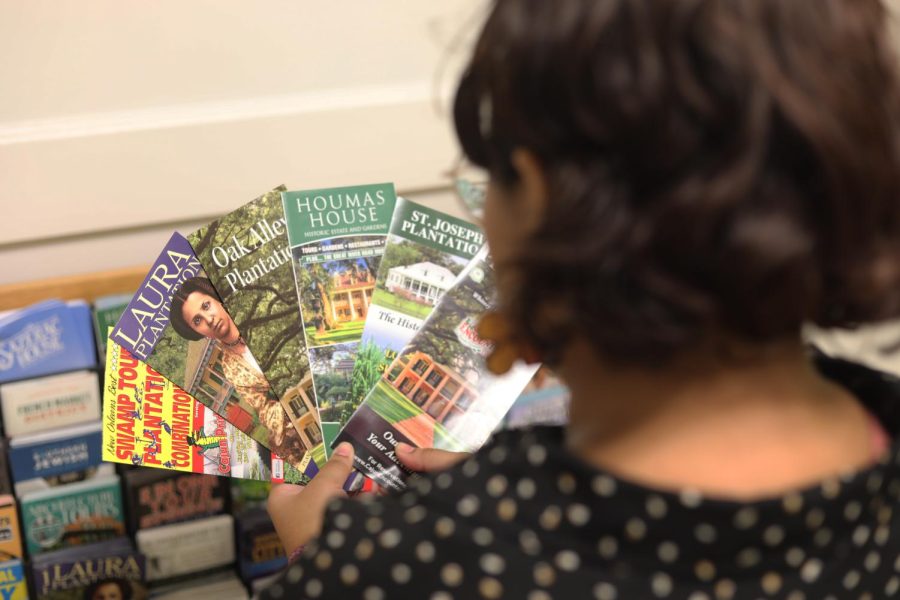EDITORIAL: Plantations aren’t tourist attractions
February 17, 2023
Picture this: You’re standing by the Danna Center post office, perusing through the rows of tourist brochures, awaiting your next New Orleans outing.
Images of Audubon Park, Jackson Square, and Bourbon Street dance across the covers of dozens of tri-fold pamphlets, inviting you to the “best places to be in the ‘Big Easy.’”
But in between brochures of New Orleans decadence are brochures that feature “beautiful mansions and grounds that deserve to be explored.”
These “beautiful mansions” sit atop soil sowed by slavery. These “beautiful grounds,” whose roots are buried in the brutal treatment of Black people. These preserved plantations fail to preserve history and are nothing more than thinly-veiled tourist attractions.
Their history, and the history of Black Americans, deserves to be acknowledged for what it is.
Black culture is a vital part of the culture and history of New Orleans and failing to acknowledge that only further erases their history.
Plantation tourism has become a commodity for onlookers to “ooh” and “ahh” while passively dismissing the pain and suffering that permeates the ground they’re walking on.
Plantation tourism should not be a form of entertainment but rather, a form of education.
Many Black people live with the trauma of their ancestors every day, while the site of this trauma acts as a stoic venue for graduation pictures and wedding ceremonies.
The sites of Black people’s trauma and suffering are not a place for holy matrimony. They are not a backdrop for your accomplishments.
The city’s leading tourist site, says Antebellum plantations “hark back to the days when cotton was king, and there were more millionaires in New Orleans than any other American city,” which only propels the erasure of Black history by failing to include that these millionaires were white. Their wealth was gained from trading slaves, as New Orleans was one of the biggest slave trading hubs in the 19th century.
Furthermore, there can simply be no mention of the economic importance of cotton production without mentioning the Black people who were forced to produce it.
Yet, NewOrleans.com conveniently fails to mention that.
Antebellum plantations are a “window into a bygone past,” according to the site.
But this past isn’t far gone. This past still exists today.
While modern-day American slavery isn’t identical to the transatlantic slave trade, Black people are still suffering at the hands of the majority. From mass incarceration to police brutality, Black people are still enslaved by systemic and societal oppression.
Even with the past still intertwined with our present, we fail to do better.
Plantation tourism is merely one example of this.
While plantations in Louisiana, like Whitney Plantation and Laura Plantation: Louisiana’s Creole Heritage Site, have made strides to reevaluate plantation tourism by becoming sites that tell the story of plantations from the perspective of enslaved people, there are still many plantations advertised across the city that gloss over the deep history of slavery.
And many of these plantations have undergone renovations that further erase the harsh realities of slavery and paint a false narrative of what plantation life would’ve been like.
But people see what they want to see.
What happened on these plantations is no secret to anyone, yet many choose to blindly follow the false narrative sold to them by those who profit from their tourism.
That’s not okay. Especially from people living in a city whose culture was largely fostered by Black people. As a country, we need to do better. But as the city of New Orleans, which was central to the U.S. slave trade, it is all the more imperative to do better.
Antebellum houses shouldn’t be torn down or abolished, but their purpose should be about educating tourists and locals alike about the complex histories of slavery, not showboating them as fancy houses with no regard for the history that haunts them.
And while plantation tourism isn’t going to change overnight, as tourists and visitors, we can choose the places we visit and how we look at them.
You can choose to visit plantations that perpetuate a white, “Gone With the Wind” narrative, or you can choose to visit Whitney Plantation, which has become a nonprofit organization run by a predominantly African-American board whose mission is to educate.
You can choose to take your upcoming graduation photos on the steps of a plantation house, or you can choose to recognize the inhumane acts of history that haunt not only the walls of these “beautiful” mansions but the Black people whose ancestors endured them.
The choice is yours.










Aaron Hernandez • Apr 18, 2023 at 9:39 am
While I acknowledge the importance of being conscience of history, many New Orleans plantations are undeniably beautiful locations that incorporate architectural concepts from a plethora of cultures. Why, as a consumer, would it be wrong or censurable for me to enjoy the artistic value of these places? And, why should the owners of the plantations alter a popular tourist attraction to be a copy of the Whitney Plantation or Laura Plantation? Slavery is an important part of history, but it is not the only part of history.